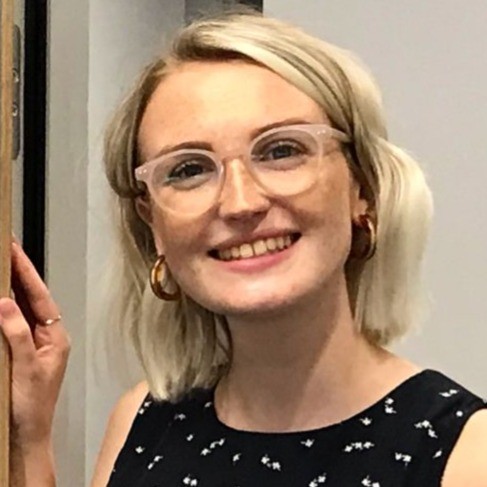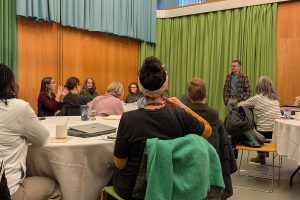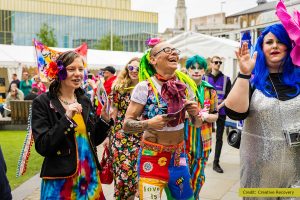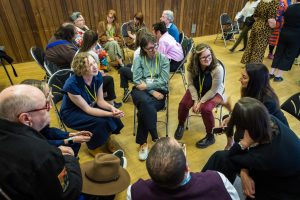
Chloe Froggatt looks back at her first six months as an Embedded Researcher within Heritage Doncaster, reflecting upon her changing approach to Participatory Action Research (PAR), and developing a sense of community within a small team.
The beginning of 2025 marks six months since I joined the UKRI Creative Health Board project as an embedded researcher (ER) in cultural organisation, Heritage, Doncaster. I’d previously worked as a researcher on University projects, often reading articles at my desk, hiding in corners of transcription rooms to avoid distractions when deadlines are looming and working almost exclusively alongside academic colleagues.
As an early career researcher, I could never have imagined the wealth of opportunities that this role would offer, each day different to the next. In this piece, I’ll share three key learnings of the initial stages of the ER role that I feel have been the most significant for me, and it goes without saying, that every ER’s experiences are different.
Firstly, creative health and wellbeing that exists within community libraries across the district of Doncaster, and how imperative these are to bringing art, culture and creativity to communities where barriers to accessing these are experienced the most.
Secondly, the importance of a gentle, quietly confident approach to entering the spaces of cultural organisations and most importantly, creative health spaces for members of the public.
Finally, working as a close-knit team of three ERs, all working collaboratively with the three cultural organisations in Doncaster’s Creative Health Board.
Creative health in community spaces
The cultural organisations on Doncaster’s creative health board, Heritage Doncaster, CAST and darts, each have inclusive, inspirational and beautiful spaces in the heart of Doncaster, which are hubs of creativity, art and culture. Heritage Doncaster is based at DANUM Gallery Library and Museum (DGLAM), a warm, welcoming and free place for all ages, abilities and interests.
There are a multitude of creative sessions held at DGLAM, but Heritage also brings sessions to community centres across the district of Doncaster, in areas where various barriers exist to engaging with creativity, art and culture. Their community outreach programme – History, Health, Happiness aims to tackle isolation and improve wellbeing. Adults who attend sessions can connect with local people, and local stories from Doncaster’s past, explore arts and history using their museum collections, share memories, experiences, and interests and learn something new through storytelling and activities.
History, Health, Happiness sessions are designed and facilitated by the wonderful Community Engagement team at Heritage, integrating the NHS’ 5 Steps to Mental Wellbeing. I have truly enjoyed my time spent in community libraries across Doncaster, often showing up early to creative health sessions to have a cuppa with volunteers who run the spaces and learning about their beloved neighbourhood. The libraries I’ve visited with Heritage are a credit to the local people who have invested their time into making the environment warm and welcoming for all – with handmade art on the walls, soft seating for afternoon chats, and of course, communal tea, coffee and biscuits as accompaniments.
Many attendees of History, Health, Happiness sessions in community spaces have lived in the neighbourhood their entire lives and very rarely journey into Doncaster centre. Some have never visited DGLAM due to a variety of reasons, such as preferring to stay local, accessibility challenges, and reliance on public transport. The impact that community spaces and creative health activities have on local people is evidenced in the stories that I’ve heard, of people using their library as a safe space in times of loneliness, meeting others and having the courage to engage with art, creativity and culture sessions, then building the confidence to design and facilitate their own creative sessions for others. Community libraries hold an abundance of stories, which I endeavour to explore, celebrate and platform as part of a PAR project.
A gentle approach to PAR
My previous research experience has informed a gentler approach when communicating and collecting data from and with participants, particularly as most of my research projects explored topics which were sensitive in nature (my research background is in women’s sexual wellbeing). I’ve visited schools to interview teaching staff about compulsory relationships and sex education, facilitated focus groups with young people about sexual wellbeing and navigated the challenges of gathering storied accounts from women about their sex lives during COVID-19. Whilst the topics of conversation were uniquely intimate, and required a specific skill set from myself – openness, non-judgemental listener, empathy, reassurance, the participants had all responded to a recruitment advertisement and wished to share their story.
The role of an embedded researcher has required additional skills when entering other people’s safe spaces, a quiet confidence, knowing when to chat to people and when to relax and let others approach you, attending creative health sessions frequently – but not too frequently in case your presence alters the organic dynamic of a session. I feel that I have a tendency to enter social situations like a bull in a china shop, not sitting still, chatting too much – you know, those classic anxious traits. Since attending Heritage Doncaster’s ‘History, Health, Happiness’ sessions, I’ve learned to slow things down, settle into a space, recognise the spatial dynamics of a room – where do people usually sit, who prefers to sit alone, the clusters of friends, the more vocal attendees and those who have additional needs, like a hearing or walking aid.
After a few weeks of hugely enjoyable content delivered by the Community Engagement Team and lots of tea and biscuits, I feared that I wasn’t making much progress and wondered if attendees would ever trust me enough and be willing to take part in a participatory action research (PAR) project. I’m six months in, and only now beginning to see more clearly how I will introduce the research process and the PAR project to attendees of creative health sessions. Again, I am mindful that this approach requires gentleness and offering the necessary information, whilst not taking too much time away from the purpose of the session – to learn, socialise, be creative and feel happier. I intend to keep a reflective log of how I approach a PAR project, when entering other people’s safe space as an embedded researcher, so if you’re interested, stay tuned!
Working as a close-knit team
Working as a close-knit team of three ERs has been invaluable as an early career researcher in not only my first role as an ER, but within an organisation. My ER colleagues on the UKRI Creative Health Board project are Emilie Taylor, embedded in CAST, Doncaster and Clair Melany, embedded in darts, Doncaster. Each day we spend together I learn something new and am in awe of the wealth of knowledge, expertise and experience that they bring to their roles. Coming from a social science background, working so closely with these creative professionals, Emilie a potter and Clair, a film maker, I’m being encouraged to step out of my comfort zone (reading journal articles and trying to figure out exactly what ontology is?) and be more creative … this is a creative health project after all!
Working as a team of ERs, has brought with it a sense of community that I hadn’t realise until recently I had been missing in my previous role as an associate lecturer, often prepping and delivering content independently. Don’t get me wrong, this has its advantages, but working more collaboratively on a weekly basis definitely enables me to expand on my skillset further and be challenged more by the team. Although, it goes without saying that the most valuable element of our little ER community is the support and guidance that we offer each other. Yes, this might be in formal meetings regarding the intricacies of research projects, but it’s also in those moments where you need a hug and a cuppa … and trust me, there’s been a few of those – we’re all human and elements of this project are highly emotive in nature.
So, to those ERs in community organisations (or ERs in any capacity) out there who are doing their best in what may feel like exciting but unknown territory, remember to lean on the research community around you, network with new ER communities or set one up yourself! Feel free to get in touch to join our network of ERs if you wish to be part of our community.




